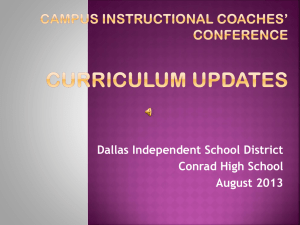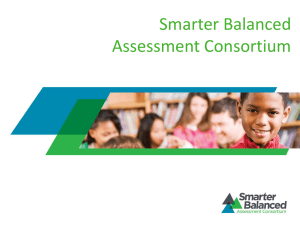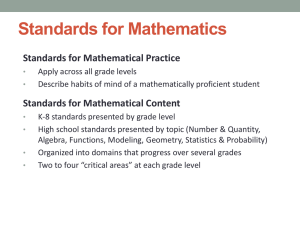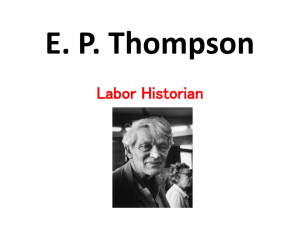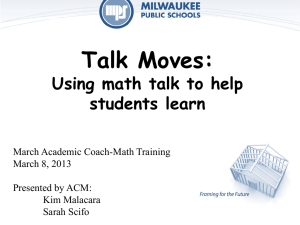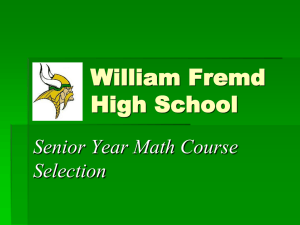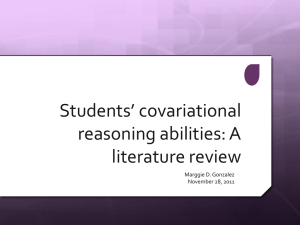to lecture slides - NIE Mathematics & Mathematics
advertisement
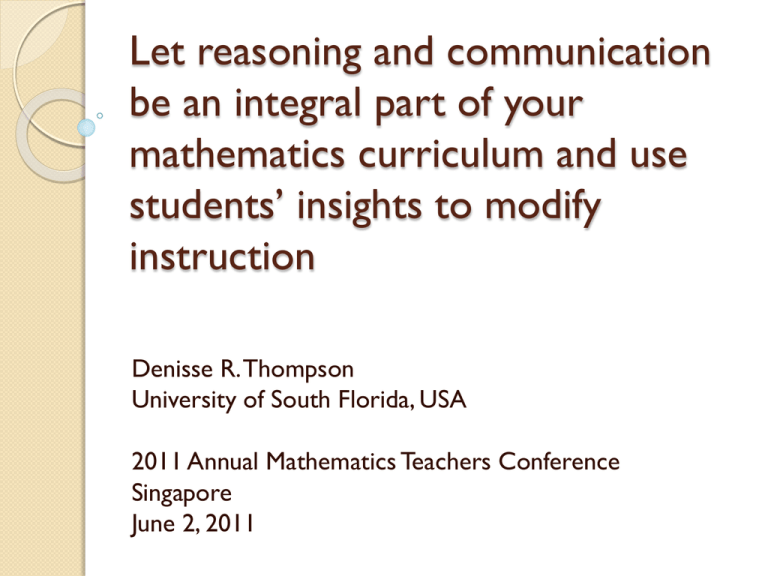
Let reasoning and communication be an integral part of your mathematics curriculum and use students’ insights to modify instruction Denisse R. Thompson University of South Florida, USA 2011 Annual Mathematics Teachers Conference Singapore June 2, 2011 Reasoning is a critical process “Reasoning mathematically is a habit of mind, and like all habits, it must be developed through consistent use in many contexts.” (Principles and Standards for School Mathematics, p. 56) Communication is also critical According to the Principles and Standards for School Mathematics (NCTM, 2000), students need to organize and consolidate their mathematical thinking through communication; communicate their mathematical thinking coherently and clearly to peers, teachers, and others; analyze and evaluate the mathematical thinking strategies of others; use the language of mathematics to express mathematics ideas precisely. Reasoning and Communication are important in Singapore’s curriculum Singapore curriculum framework Two Guiding Questions How can we ensure that students have many opportunities to engage with reasoning and mathematical communication throughout their primary curriculum? How can those opportunities provide teachers with insight into students’ thinking that can help teachers modify and enhance instruction? The Curriculum is Key The textbook is a “variable that on the one hand we can manipulate and on the other hand does affect student learning.” (Begle, 1973, p. 209) Look for opportunities within the textbook, and when not present, consider how we might modify items or tasks to engage students in reasoning, communicating about mathematics, and explaining their thinking. Strategy 1: Reframe basic problems to add conditions Typical: 12 + 8 = ____; 12 8 = ____ Possible revision. Find two whole numbers whose sum is 16 and whose product is 48. Explain why your numbers are correct. How did you start to think about the problem? Strategy 1: Reframe basic problems to add conditions Notice that students have to attend to two conditions simultaneously. Foreshadows later work with algebra: x + y = 16 and xy = 48. This type of task can be asked throughout the grades with increasingly larger numbers. Sample Responses (Thompson & Schultz-Ferrell, 2008) Strategy 2: Given a set of conditions, consider changing the conditions Typical problem: 9 + 2 + 1 = _____ Possible revision: Balpreet has 12 pounds of chocolate to package in three identical containers: ◦ Each container has a whole number of pounds. ◦ Each container has some chocolate in it. ◦ No two containers have the same number of pounds. ◦ All 12 pounds of chocolate must be used. A. Find one way to distribute the chocolate. B. Find all possible ways to distribute the chocolate. C. How do you know you have all the ways? D. How does the answer change if you change one or more of the conditions? (adapted from Thompson & Shultz-Ferrell, 2008) Sample Response From Thompson & Schultz-Ferrell, 2008 Strategy 3: Use one result to find patterns or predict other results Typical: Multiply 6.5 by 5. Possible revision: A. Multiply 6.5 by a number so that the product is between 110 and 140. Record the numbers you try. How did you decide what numbers to try? B. Multiply 6.5 by a number so that the product is between 1100 and 1400. Explain how your work in A could help you do this problem in one step. C. Multiply 0.65 by a number so that the product is between 1100 and 1400. How does your work in A or B help you answer this problem? (adapted from Thompson & Schultz-Ferrell, 2008) Strategy 3: Use one result to find patterns or predict other results In the book, Two of Everything by Lily Toy Hong, an old man finds a brass pot that doubles everything put into it. They put five coins in the pot and take out 10, put 10 in the pot and take out 20, and so on. Predict how long it will take to collect at least 1,000,000 coins. What did you think about? What if the brass pot triples what is placed inside it instead of doubling it? How would this change the amount of time it takes to get at least 1,000,000 coins? Strategy 4: Turn concepts into conjectures for students to investigate Typical problem: Evaluate 4(5 + 2). Possible revision: For all real numbers 3, x and y, is it true that 3(x – y) = 3x – y? __ Yes __ No Suppose you had to convince a person in another class that your answer is correct. Explain your reasoning. Second revision: For all real numbers 3, x, and y, is 3(x – y) = 3x – y always true, sometimes true, or never true. Justify your answer. Sample responses Response A Response B Another example Typical problem: A quadrilateral has three angles with measures 100, 60, and 130. What is the measure of the 4th angle? Possible revision: Is it possible for a quadrilateral to have four obtuse angles? How do you know? ◦ Can a triangle have more than one obtuse angle? Explain your thinking. ◦ Can a quadrilateral have two obtuse angles? If so, draw a picture. If not, explain why not. ◦ Can a quadrilateral have three obtuse angles? If so, draw a picture. If not, explain why not. Show that a quadrilateral cannot have four obtuse angles. ◦ Less opportunity for reasoning Strategy 5: Encourage students to solve a problem in multiple ways Typical problem: Find the area. 5 cm 3 cm Strategy 5: Encourage students to solve a problem in multiple ways Possible revision: The distance between two dots, horizontally, or vertically, is 1 unit. Find the area in as many ways as possible. Explain why your answer is correct. Sample Responses Response A Response B Strategy 6: Evaluate someone else’s thinking and use their approach on a new problem Use the approach of Student A from the geometry grid problem to find the area of the following figure. Strategy 7: Turn the question around Typical question: What shape is this? Possible revision: Determine the most specific figure described by the clues and explain why you believe your answer is correct. Could any clues by omitted without changing your answer. Explain your thinking. ◦ ◦ ◦ ◦ four sides opposite sides parallel all sides congruent diagonals congruent Write a set of clues for a specific geometric figure. Read your clues to a friend. Did your friend identify the figure you intended? If not, determine why not and revise your set of clues. Strategy 7: Turn the question around Typical question: What fraction represents the shaded part? Possible revision: Draw a picture to show 3/8. Explain how you know your picture shows the given fraction. Use a different model and draw another picture that represents 3/8. Explain how your two models are alike and how they are different. Strategy 8: Write a story for a problem The graph shows Ruby's distance from home on a trip to visit her grandmother. On the trip she went shopping and had a leisurely lunch. What is the farthest distance Ruby traveled from home? How do you know? Which parts of the graph could represent Ruby's shopping time, her leisurely lunch, and her visit with her grandmother? Explain your thinking. Write a story to describe the graph so that someone who cannot see the graph could construct it. Strategy 8: Write a story for a problem Typical problem: 5.68 2.34 Possible revision: Make up a word problem whose answer is given by 5.68 2.34. Sample responses Joan went to the candy store. She bought 5.68 pounds of peppermint candy and 2.34 pounds of gummy bears. How many lbs of candy did Joan buy in all? Each pound of candy was 2.34. I bought 5.68. How much? There are 5.68 billion people in the world. Everyone has 2.34 different books. How many books are there in the world? (Chappell & Thompson, 1999) Strategy 9: Find ways to connect conceptual and procedural knowledge We need to connect skills, with applications, with visual representations. Mathematics Example Real-life Example Visual Example Explanation in Words (From Thompson, Kersaint, Richards, Hunsader, & Rubenstein, 2008, adapted from Shield & Swinson, 1996) Sample Response for Fraction Addition (Thompson et al., 2008) Sample Response for Fraction Multiplication (Thompson et al., 2008) General Strategies for Modifying Items Use vocabulary and regular questions to signal that reasoning and communication beyond a numerical answer are expected. ◦ ◦ ◦ ◦ ◦ ◦ ◦ ◦ ◦ ◦ Explain. Explain why. Why? Does it work every time? How do you know? Show. Show that. Convince me. Do you agree or disagree with the solution shown? How are these problems (or answers) alike or different? How could you do the problem a different way? General Ideas for Modifying Items Highlight concepts that you know are potential difficulties for students ◦ Through investigating conjectures ◦ Through identifying common errors ◦ Through creating an argument and having students evaluate it Use examples of student work (anonymously) to generate tasks, particularly for evaluating arguments or correcting mistakes General Ideas for Modifying Items Consider using language that does not give away the answer ◦ Is it always, sometimes, or never true? ◦ True or false ◦ Is the student correct? Why or why not? Replace 1 or 2 problems in each homework assignment with tasks in which students are expected to engage in reasoning ◦ Students need to be convinced that such tasks are not going away Your Turn at Modifying Items With someone near you, take two of the following problems and write 1 modification for each to engage students in reasoning or communication. Number: 825 5 = 8 cm Measurement: Find the perimeter 3 cm and area of the rectangle. Data: Find the mean, median, and mode of a set of data. Geometry: Find the volume of a box with dimensions 4 cm by 2 cm by 8 cm. Algebraic Thinking: Simplify (52 – 2) 10 Sample Modifications Number: Marcella had 825 cupcakes and sold all but 5. If she sold them in packages, what might be the size and number of the packages? How do you know? Measurement: Is it possible for two rectangles to have an area of 24 sq cm but have different perimeters? Explain how you know. (Chappell & Thompson, 1999) Data: Find five data values so the mean is 25 and the median is 18. Sample Modifications Geometry: Can two different boxes have the same area for the base but different volumes? Can two different boxes have different dimensions for the base but the same volume? Explain. Algebraic Thinking: I’m thinking of a number. I subtract 2. Divide by 10. I get 5. What was the number I was thinking of? Include Reasoning and Communication Tasks in Assessments Students need to see such tasks as not only something to occur during instruction but something to occur during assessment as well. What counts for a grade is often what students value Thank you! denisse@usf.edu References Chappell, M. F., & Thompson, D. R. (1999). Modifying our questions to assess students’ thinking. Mathematics Teaching in the Middle School, 4, 470-474. Chappell, M. F., & Thompson, D. R. (1999). Perimeter or area? Which measure is it? Mathematics Teaching in the Middle School, 5, 20-23. Hong, L. T. (1993). Two of everything. Morton Grove, IL: Albert Whitman & Company,. National Council of Teachers of Mathematics. (2000). Principles and standards for school mathematics. Reston,VA: Author. Shield, Mal, and Kevan Swinson. 1996. "The Link Sheet: A Communication Aid for Clarifying and Developing Mathematical Ideas and Processes." In Communication in Mathematics, K-12 and Beyond, edited by Portia C. Elliott and Margaret J. Kenney, 35-39. Reston,VA: National Council of Teachers of Mathematics. Thompson, D. R., Kersaint, G., Richards, J. C., Hunsader, P. D., & Rubenstein, R. N. (2008). Mathematical literacy: Helping students make meaning in the middle grades. Portsmouth, NH: Heinemann. Thompson, D. R. , & Schultz-Ferrell, K. (2008). Introduction to reasoning and proof in grades 6-8. Portsmouth, NH: Heinemann.
